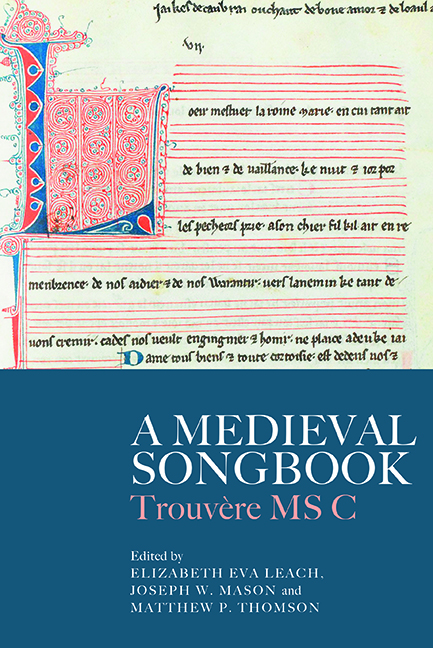Book contents
- Frontmatter
- Contents
- List of Illustrations
- List of Music Examples
- List of Tables
- List of Contributors
- Acknowledgements
- Abbreviations
- Editorial Practices
- Introduction
- Chapter 1 The Trouvère Manuscripts of the Burgerbibliothek Bern
- Chapter 2 The Lorraine Repertoire of C
- Chapter 3 Chansonnier C: Contents, Stemmatic Position, Particularities
- Chapter 4 A Note on the Decoration of C and its Artistic Context
- Chapter 5 Author Ascriptions and Genre Labels in C
- Chapter 6 Common Exemplars of U and C
- Chapter 7 Shared Small Sources for Two Early Fourteenth-Century Metz Chansonniers?
- Chapter 8 The Legacy of Thibaut de Champagne in C
- Chapter 9 Strategies of Appropriation in Jacques de Cambrai's Devotional Contrafacts
- Chapter 10 Jeux-Partis and their Contrafacts in C
- Chapter 11 C and Polyphonic Motets: Exemplars, Adaptations, and Scribal Priorities
- Appendix: List of Songs in C
- Bibliography
- Index of Sources
- Index of Songs
- General Index
- Studies in Medieval and Renaissance Music
Chapter 6 - Common Exemplars of U and C
Published online by Cambridge University Press: 26 May 2022
- Frontmatter
- Contents
- List of Illustrations
- List of Music Examples
- List of Tables
- List of Contributors
- Acknowledgements
- Abbreviations
- Editorial Practices
- Introduction
- Chapter 1 The Trouvère Manuscripts of the Burgerbibliothek Bern
- Chapter 2 The Lorraine Repertoire of C
- Chapter 3 Chansonnier C: Contents, Stemmatic Position, Particularities
- Chapter 4 A Note on the Decoration of C and its Artistic Context
- Chapter 5 Author Ascriptions and Genre Labels in C
- Chapter 6 Common Exemplars of U and C
- Chapter 7 Shared Small Sources for Two Early Fourteenth-Century Metz Chansonniers?
- Chapter 8 The Legacy of Thibaut de Champagne in C
- Chapter 9 Strategies of Appropriation in Jacques de Cambrai's Devotional Contrafacts
- Chapter 10 Jeux-Partis and their Contrafacts in C
- Chapter 11 C and Polyphonic Motets: Exemplars, Adaptations, and Scribal Priorities
- Appendix: List of Songs in C
- Bibliography
- Index of Sources
- Index of Songs
- General Index
- Studies in Medieval and Renaissance Music
Summary
The close relationship between the Messine chansonniers Saint-Germain-des-Près (U) and Bern 389 (C) is already suggested by their layout. Both are written as a single column: U has twenty-six, C twenty-eight lines per page. Their text blocks differ in size by only one centimetre in height and two in width. Their physical appearance is thus quite similar, aside from C's broader margins and richer decoration (see Figure 6.1). One can only speculate as to the kind of notation that was planned for C and the reason that no melodies were entered.
As regards their content, C and U have 211 songs in common, which amounts to almost two thirds of the total repertoire of U and 40% of C. It would seem that the older chansonnier U was, in some way or other, used extensively by the compiler of C. In this contribution, I offer some insights into the way that U was used, and into the hidden world of exemplars.
Letter-section M
Songs found in U are often inserted singly or in small groups into the succession of songs in C; however, frequently they form larger clusters. For instance, of the twenty songs in letter-section A that are also found in U, twelve constitute a sequence (nos 29–41) in C, interrupted by one unicum only (no. 37). Letter-section Q shows a similar sequence: of its eighteen songs that it shares with U, fifteen are in a single unit as nos 418–33, with one unicum intervening (no. 425). The most astonishing cluster is found in letter-section M (see Table 6.1).
Fourteen of these twenty-seven songs are transmitted by U, and immediately after the usual religious opening song, all of them form a sequence (nos 314–28), with only one unicum intervening (no. 323). In this letter-section, the compiler has apparently formed two groups: songs contained in U, and songs from other sources, with a series of anonymous songs at the end. Remarkably, these fourteen songs of the first group represent all of U's pieces beginning with ‘M’, with the exception of one political song, which, more than two generations later, may have seemed obsolete to the compiler of C and was intentionally omitted.
- Type
- Chapter
- Information
- A Medieval SongbookTrouvère MS C, pp. 82 - 120Publisher: Boydell & BrewerPrint publication year: 2022



